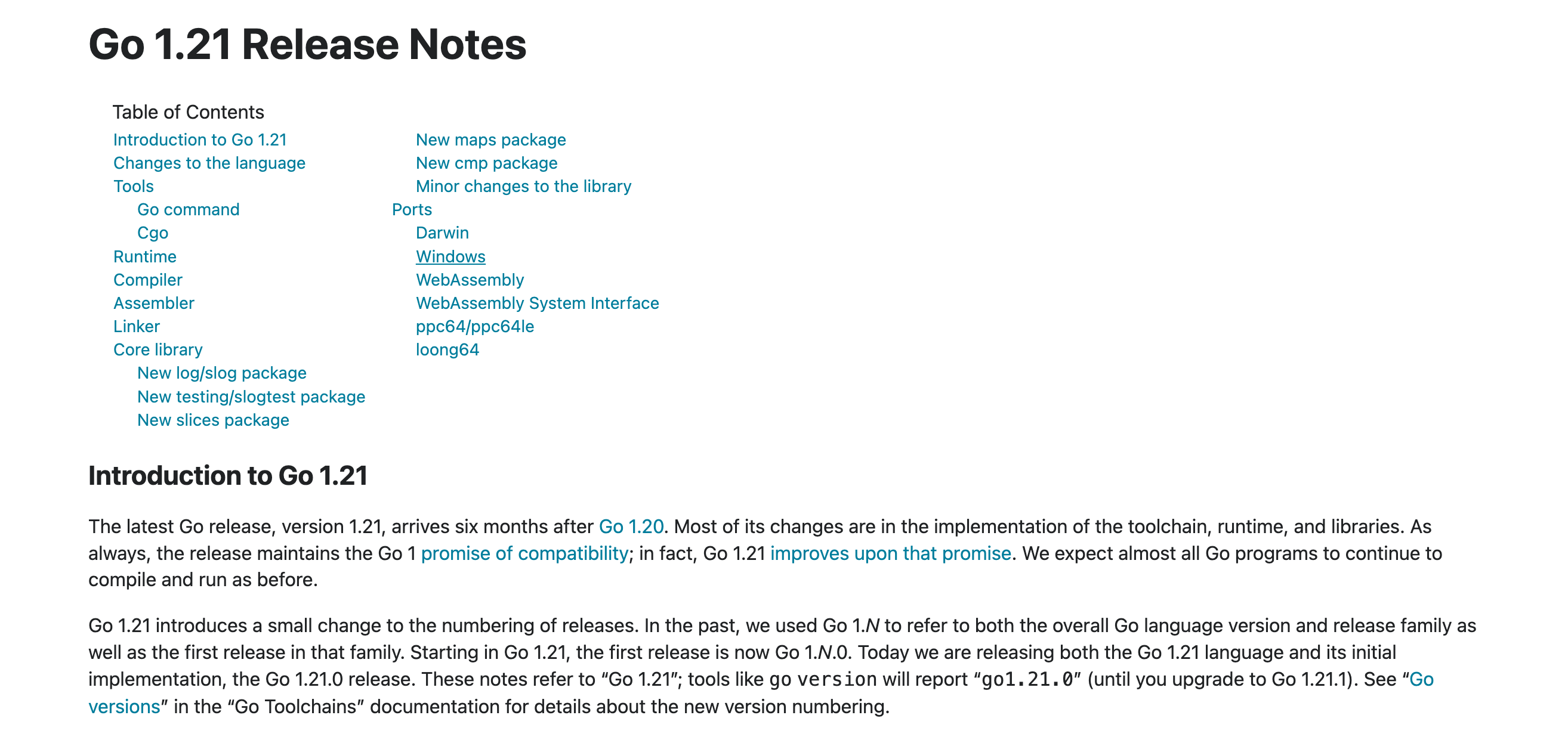大家好,我是南哥。
Go1.21 在8月8日晚上 11 点 30 多的时候,终于发布出来了,这个版本比较重要,加入了很多新特性,下面我带大家尝鲜。

1.21.0 简介
最新的 Go 1.21版本,在 Go 1.20 六个月后发布。它的大部分更改都在工具链、运行时和库的实现中。与往常一样,该版本保持了Go 1的兼容性承诺。
Go 1.21 对版本的编号进行了一个小的更改。过去,我们使用 Go 1.N 来指代整个 Go 语言版本和发行版系列以及该系列中的第一个版本。从 Go 1.21 开始,第一个版本现在是 Go 1.N.0。今天,我们将发布 Go 1.21 语言及其初始实现 Go 1.21.0 版本。
go 现在支持向后和向前语言兼容性,大家放心升级。
语言改变
Go 1.21 为该语言添加了三个新的内置函数。
- 新函数 min 并 max 计算固定数量的给定参数的最小(或最大 max )值
- 新函数 clear 从 map 中删除所有元素或将 slice 的所有元素归零
对泛型函数的类型推断进行了几项改进。规范中对类型推断的描述已得到扩展和澄清
在 Go 的未来版本中,我们计划解决 Go 编程中最常见的问题之一:循环变量捕获。Go 1.21 附带了此功能的预览,您可以使用环境变量在代码中启用该功能。
标准库添加
用于结构化日志记录的新日志/日志包 log/slog
新的 slice 包,用于对任何元素类型的切片进行常见操作
新的 map 包 ,用于对任何键或元素类型的映射进行常见操作
新的 cmp 包,带有用于比较有序值的新实用程
性能改进
- 启用 PGO 提升编译性能
- 调整垃圾回收
- 优化对 amd64 和 arm64 对于 trace 的CPU 消耗
支持 WASI
Go 1.21 为 WebAssembly System Interface (WASI) 添加了一个实验性端口,预览版 1 ( GOOS=wasip1 , GOARCH=wasm )。
代码
clear
Go 1.21增加了一个clear预定义函数用来做切片和map的clear操作,其原型如下:
// The clear built-in function clears maps and slices.
// For maps, clear deletes all entries, resulting in an empty map.
// For slices, clear sets all elements up to the length of the slice
// to the zero value of the respective element type. If the argument
// type is a type parameter, the type parameter's type set must
// contain only map or slice types, and clear performs the operation
// implied by the type argument.
func clear[T ~[]Type | ~map[Type]Type1](t T)
clear是针对map和slice的操作函数,它的语义是什么呢?我们通过一个例子来看一下:
package main
import "fmt"
func main() {
var sl = []int{1, 2, 3, 4, 5, 6}
fmt.Printf("before clear, sl=%v, len(sl)=%d, cap(sl)=%d\n", sl, len(sl), cap(sl))
clear(sl)
fmt.Printf("after clear, sl=%v, len(sl)=%d, cap(sl)=%d\n", sl, len(sl), cap(sl))
var m = map[string]int{
"tony": 13,
"tom": 14,
"amy": 15,
}
fmt.Printf("before clear, m=%v, len(m)=%d\n", m, len(m))
clear(m)
fmt.Printf("after clear, m=%v, len(m)=%d\n", m, len(m))
}
slog
包 slog 提供结构化日志记录,其中日志记录包括消息、严重性级别和表示为键值对的各种其他属性。
它定义了一个类型,Logger,它提供了几种方法(如 Logger.Info 和Logger.Error)来报告感兴趣的事件。
每个记录器(Logger)都与一个处理程序(Handler)相关联。记录器输出方法从方法参数创建 Record,并将其传递给处理程序,处理程序决定如何处理它。有一个默认记录器,可通过调用相应记录器方法的顶级函数(如信息和错误)访问。
日志记录(Logger)由时间、级别、消息和一组键值对组成,其中键是字符串,值可以是任何类型的。实际使用:
slog.Info("hello", "count", 3)
//2023/08/09 10:36:18 INFO hello count=3
cmp
包 cmp 提供与比较有序值相关的类型和函数,原型如下:
// Compare returns
//
// -1 if x is less than y,
// 0 if x equals y,
// +1 if x is greater than y.
//
// For floating-point types, a NaN is considered less than any non-NaN,
// a NaN is considered equal to a NaN, and -0.0 is equal to 0.0.
func Compare[T Ordered](x, y T) int {
xNaN := isNaN(x)
yNaN := isNaN(y)
if xNaN && yNaN {
return 0
}
if xNaN || x < y {
return -1
}
if yNaN || x > y {
return +1
}
return 0
}
实际使用如下:
result := cmp.Compare(2, 3)
slog.Info("2 cmp 3", "result", result)
//2023/08/09 10:39:04 INFO 2 cmp 3 result=-1
min
minResult := min(2, 4, 5, 5, 56)
slog.Info("min 2,3,4,5,56", "result", minResult)
//2023/08/09 10:42:37 INFO min 2,3,4,5,56 result=2
